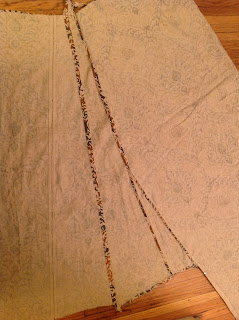After roughing in the carving for the handle I cut a groove across the top plate of my handle base and inserted a craft wood oval to provide support for the feathers of my fan and also the fantastic animals which project to the sides.

Since I couldn't find my coping saw, or any of my other, more suitable, saws. I made the grove by working at it a whole lot with a combination of the tools I could find, a drywall saw, chisel and my wonderful hand drills. Really, the proper tools would have made this stage a whole lot easier but, as you can see, it worked!

I glued the craft wood oval into place with ordinary white glue and let it dry overnight.

Then I sized Orsi's original design to the appropriate scale and printed it out so that I would have a reference for the next stage-modeling the figures!
I should probably mention that I have been very tempted to just finish the fan handle at this stage. It is very comfortable to hold and has a lovely shape. All that is needed is some smoothing, sanding, and a cover for the place where the brass ring joins the wood and it would be ready to paint. But it wouldn't be Orsi's fan. :) Thus, I persevere.
Although I cannot find it at present, another period artwork inspired me to try making a feather fan in which one side is white feathers, the other black, and you see the reverse color where the feathers curl over at the tips. Since I've given my handle a central support structure I need to create spaces between that central piece and the outer cover in which to insert my feathers.

I stacked up cut up pieces of a cardboard box and sections of the cardboard core of a paper towel roll until they seemed thick enough and then wrapped them in plastic wrap in the hope that the plastic wood won't adhere.

I tied the assembled spacer to my framing with thread. I hope it will be easy to cut free when the time comes.
Next up: Plastic wood! I started applying the plastic wood at the acorn knob at the bottom of my fan and discovered that it doesn't really mold and model in the way I remember. It is too soft at the start, and cracks and flakes off as it dries as I'm working it. Furthermore, it doesn't really want to adhere to the existing framework. It seems to respond best to repeated tapping and thinner layers so I am going to try roughing in the sculpted shapes I need and adding in depth and detail in layers.
Here is my first pass at side one.

It doesn't look like much right now, but I think it has potential.







































